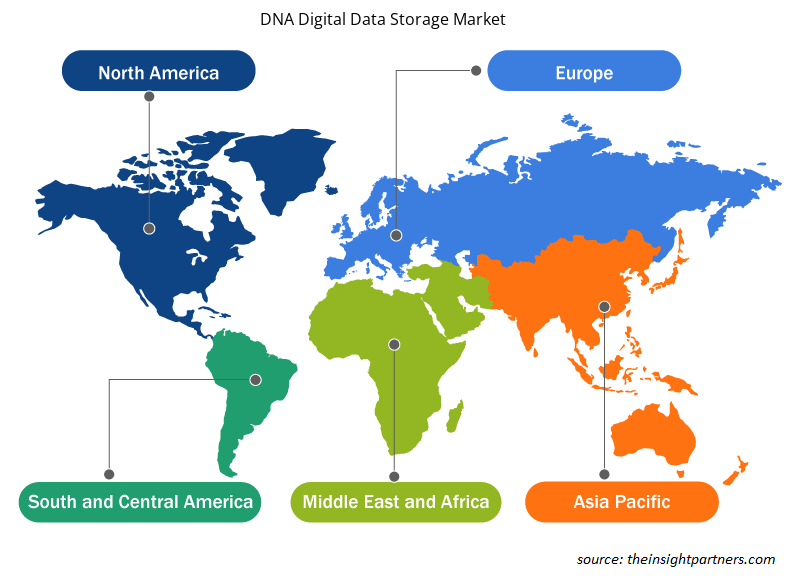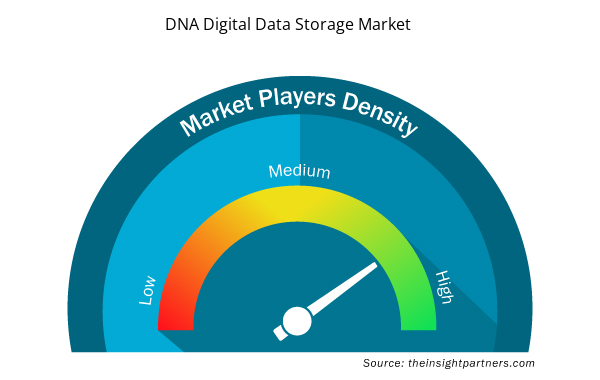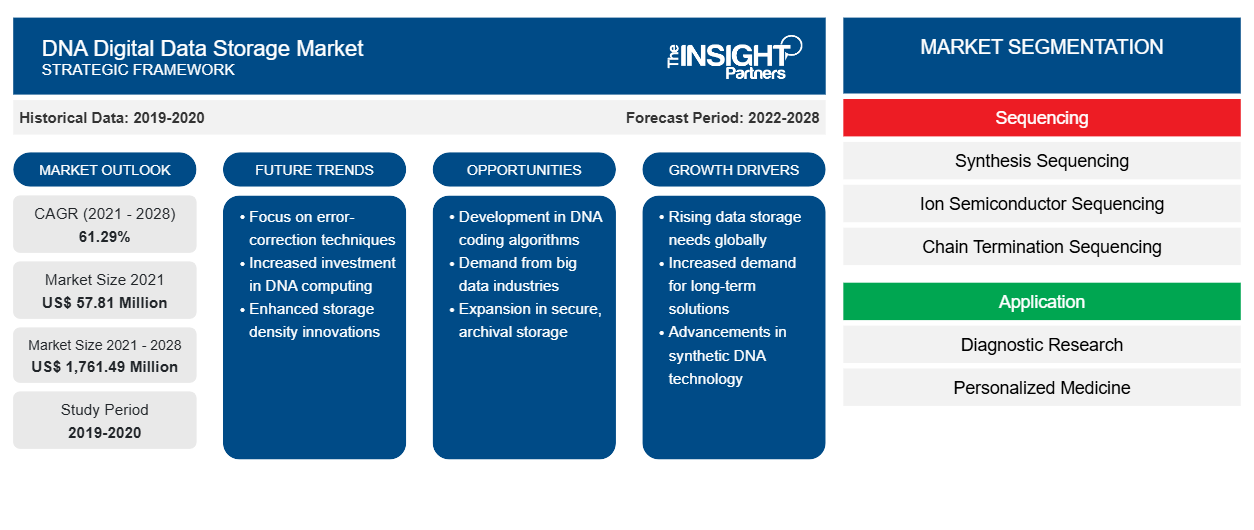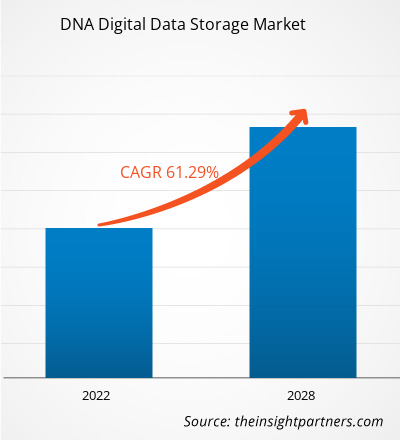Si prevede che il mercato dell'archiviazione dei dati digitali del DNA crescerà da 57,81 milioni di dollari nel 2021 a 1.761,49 milioni di dollari entro il 2028; si stima che crescerà a un CAGR del 61,29% nel periodo 2021-2028.CAGR of 61.29% during 2021 to 2028.
L'archiviazione di dati digitali del DNA è il metodo di codifica e decodifica di dati binari da e verso filamenti sintetizzati di DNA. Il DNA ha suscitato interesse come mezzo per l'archiviazione di informazioni digitali grazie alla sua elevata densità di archiviazione e alla sua durevolezza, superiore a quelle dei supporti di archiviazione esistenti basati sul silicio. Inoltre, il codice nucleotidico a quattro lettere del DNA fornisce un ambiente di codifica adatto che può essere utilizzato nello stesso modo in cui i computer e altri dispositivi elettrici utilizzano il codice digitale binario per rappresentare qualsiasi lettera, cifra o altro carattere.
Personalizza questo report in base alle tue esigenze
Riceverai la personalizzazione gratuita di qualsiasi report, comprese parti di questo report, o analisi a livello nazionale, pacchetto dati Excel, oltre a usufruire di grandi offerte e sconti per start-up e università
- Scopri le principali tendenze di mercato in questo rapporto.Questo campione GRATUITO includerà analisi di dati che spaziano dalle tendenze di mercato alle stime e alle previsioni.
I fattori che guidano la crescita del mercato globale di archiviazione dati digitali del DNA sono la presenza di fornitori di servizi di archiviazione dati digitali del DNA e gli investimenti attivi e l'innovazione aziendale correlati all'archiviazione dati del DNA sono tra i fattori che rafforzano la crescita del mercato. Tuttavia, la disponibilità di alternative e le limitazioni associate stanno ostacolando la crescita del mercato. Nonostante queste limitazioni, le crescenti applicazioni di archiviazione dati del DNA creerebbero un'enorme opportunità per gli operatori che operano nel mercato di archiviazione dati digitali del DNA durante il periodo di previsione.
Approfondimenti di mercato
Applicazioni crescenti di archiviazione dei dati del DNA
L'archiviazione dei dati del DNA sta guadagnando popolarità tra i fornitori di servizi sanitari e associati. Medicina forense, medicina personalizzata , diagnostica e altri sono alcuni dei campi di applicazione dell'archiviazione dei dati del DNA. L'archiviazione del DNA offre un'archiviazione dei dati a lungo termine rispetto alle modalità di archiviazione tradizionali. Si prevede che la crescente domanda di spazi dati più piccoli per archiviare quantità maggiori di dati creerà opportunità per gli operatori di mercato. Gli archivi dei dati del DNA sono utilizzati ed esplorati da aziende farmaceutiche, istituti di ricerca e agenzie di sicurezza per archiviare il massimo dei dati in uno spazio più piccolo.
Esiste un potenziale significativo per l'innovazione e lo sviluppo del prodotto poiché la tecnologia di archiviazione del DNA è nella fase iniziale di sviluppo e non è ancora commercializzata su larga scala. Diverse aziende e organizzazioni di ricerca sono attivamente coinvolte nelle attività di sviluppo dell'archiviazione del DNA. Ad esempio, nell'agosto 2021, i ricercatori dell'Università di Washington e Microsoft hanno sviluppato NANOPORE-TAL, che consentirà alle cellule di comunicare con i computer. Inoltre, nel 2021, Microsoft, in collaborazione congiunta con l'Università di Washington presso il Molecular Information Laboratory, ha lavorato su un nuovo chip per dimostrare la capacità di impacchettare i punti di sintesi del DNA tre ordini di grandezza più strettamente e dimostrare una maggiore produttività di scrittura del DNA. Pertanto, si prevede che le crescenti applicazioni dell'archiviazione dei dati del DNA creeranno opportunità redditizie per gli operatori del mercato dell'archiviazione dei dati digitali del DNA e altri utenti finali in futuro.
Approfondimenti basati sul sequenziamento
Il mercato dell'archiviazione dei dati digitali del DNA, tramite sequenziamento , è segmentato in sequenziamento di sintesi, sequenziamento di semiconduttori ionici, sequenziamento di terminazione di catena, sequenziamento di legatura, sequenziamento di nanopori. Nel 2021, è probabile che il segmento del sequenziamento di sintesi deterrà la quota maggiore del mercato. Tuttavia, si prevede che il segmento del sequenziamento di nanopori crescerà al ritmo più rapido nei prossimi anni.
Approfondimenti basati sulle applicazioni
Il mercato dell'archiviazione dei dati digitali del DNA, in base all'applicazione, è segmentato in ricerca diagnostica, medicina personalizzata e altri. È probabile che il segmento della ricerca diagnostica deterrà la quota maggiore del mercato nel 2021 e si prevede che registrerà il CAGR più elevato nel mercato durante il periodo di previsione.
Approfondimenti regionali sul mercato dell'archiviazione dei dati digitali del DNA
Le tendenze regionali e i fattori che influenzano il mercato di archiviazione dati digitali del DNA durante il periodo di previsione sono stati ampiamente spiegati dagli analisti di Insight Partners. Questa sezione discute anche i segmenti e la geografia del mercato di archiviazione dati digitali del DNA in Nord America, Europa, Asia Pacifico, Medio Oriente e Africa e America meridionale e centrale.

- Ottieni i dati specifici regionali per il mercato dell'archiviazione dei dati digitali del DNA
Ambito del rapporto sul mercato dell'archiviazione dei dati digitali del DNA
| Attributo del report | Dettagli |
|---|---|
| Dimensioni del mercato nel 2021 | 57,81 milioni di dollari USA |
| Dimensioni del mercato entro il 2028 | 1.761,49 milioni di dollari USA |
| CAGR globale (2021 - 2028) | 61,29% |
| Dati storici | 2019-2020 |
| Periodo di previsione | 2022-2028 |
| Segmenti coperti | Per sequenziamento
|
| Regioni e Paesi coperti | America del Nord
|
| Leader di mercato e profili aziendali chiave |
|
Densità dei player del mercato dell'archiviazione dei dati digitali del DNA: comprendere il suo impatto sulle dinamiche aziendali
Il mercato del DNA Digital Data Storage Market sta crescendo rapidamente, spinto dalla crescente domanda degli utenti finali dovuta a fattori quali l'evoluzione delle preferenze dei consumatori, i progressi tecnologici e una maggiore consapevolezza dei vantaggi del prodotto. Con l'aumento della domanda, le aziende stanno ampliando le loro offerte, innovando per soddisfare le esigenze dei consumatori e capitalizzando sulle tendenze emergenti, il che alimenta ulteriormente la crescita del mercato.
La densità degli operatori di mercato si riferisce alla distribuzione di aziende o società che operano in un particolare mercato o settore. Indica quanti concorrenti (operatori di mercato) sono presenti in un dato spazio di mercato in relazione alle sue dimensioni o al valore di mercato totale.
Le principali aziende che operano nel mercato dell'archiviazione dei dati digitali del DNA sono:
- Illumina, Inc
- Twist Bioscienza
- Agilent Technologies, Inc
- Assemblaggi molecolari
- Società quantistica
Disclaimer : le aziende elencate sopra non sono classificate secondo un ordine particolare.

- Ottieni una panoramica dei principali attori del mercato dell'archiviazione dei dati digitali del DNA
Informazioni basate sull'utente finale
Il mercato dell'archiviazione dei dati digitali del DNA, in base all'utente finale, è segmentato in istituti accademici e di ricerca, aziende farmaceutiche e biotecnologiche, ospedali e cliniche e altri. È probabile che il segmento degli istituti accademici e di ricerca deterrà la quota maggiore del mercato nel 2021 e si prevede che registrerà il CAGR più elevato nel mercato durante il periodo di previsione
I lanci e le approvazioni di prodotti sono strategie comunemente adottate dalle aziende per espandere la loro presenza globale e i loro portafogli di prodotti. Inoltre, gli operatori del mercato dell'editing del genoma si concentrano sulla strategia di partnership per ampliare la loro clientela, il che, a sua volta, consente loro di mantenere il loro marchio a livello globale.
Profili aziendali
- Illumina, Inc.
- Twist Bioscienza
- Agilent Technologies, Inc.
- Assemblaggi molecolari
- Società quantistica
- CATALOGARE
- Società Microsoft
- Iridia, Inc
- F. HOFFMANN-LA ROCHE LTD
- Scrittura del DNA
- Evonetix.
- Analisi storica (2 anni), anno base, previsione (7 anni) con CAGR
- Analisi PEST e SWOT
- Valore/volume delle dimensioni del mercato - Globale, regionale, nazionale
- Industria e panorama competitivo
- Set di dati Excel


- Hydrolyzed Collagen Market
- Digital Pathology Market
- Machine Condition Monitoring Market
- Skin Graft Market
- Electronic Signature Software Market
- Sexual Wellness Market
- Nuclear Waste Management System Market
- Vessel Monitoring System Market
- Legal Case Management Software Market
- Environmental Consulting Service Market

Report Coverage
Revenue forecast, Company Analysis, Industry landscape, Growth factors, and Trends

Segment Covered
This text is related
to segments covered.

Regional Scope
North America, Europe, Asia Pacific, Middle East & Africa, South & Central America

Country Scope
This text is related
to country scope.
Domande frequenti
The global DNA digital data storage market based on sequencing is segmented into, Synthesis Sequencing, Ion Semiconductor Sequencing, Chain Termination Sequencing, Ligation Sequencing, and Nanopore Sequencing. In 2021, the synthesis sequencing segment held the largest share of the market by technology whereas, nanopore sequencing is expected to witness fastest CAGR during 2021 to 2028, due to increasing utilization of this technology at global level.
The global DNA digital data storage market is segmented into North America, Europe, Asia Pacific, Middle East & Africa, and South & Central America. The North American area holds the largest market for DNA digital data storage. The United States held the most significant DNA digital data storage market and is expected to grow due to factors such as the transformation of digital healthcare and growing investments while the technological advancements by key players in DNA digital data storage is also boosting the growth rate in US.
The Asia Pacific region is expected to account for the fastest growth in the DNA digital data storage market. In Japan, India and South Korea, the market is expected to grow owing to the ongoing research activities related to DNA digital data storage and technology penetration in the region.
Several factors are believed to affect DNA digital data storage market in the coming years. Factors such as presence of DNA digital data storage service providers and active investments and business innovation related to DNA data storage are driving the market growth. However, the availability of alternatives and associated limitations likely to hamper the growth of the market.
The DNA digital data storage market majorly consists of the players such as, Illumina, Inc; Twist Bioscience Agilent Technologies, Inc; Molecular Assemblies; Quantum Corporation; CATALOG; Microsoft Corporation; Iridia, Inc.; F. HOFFMANN-LA ROCHE LTD.; DNA Script; Evonetix among others.
DNA digital data storage is the method of encoding and decoding binary data to and from synthesized strands of DNA. The DNA has garnered interest as a medium for digital information storage due to its high storage density and durability that is superior to those of existing silicon-based storage media. Moreover, DNA’s four-letter nucleotide code provides a suitable coding environment that can be used in the same way that computers and other electrical devices employ binary digital code to represent any letter, digit, or other character.
Trends and growth analysis reports related to Technology, Media and Telecommunications : READ MORE..
The List of Companies - DNA Digital Data Storage Market
- Illumina, Inc
- Twist Bioscience
- Agilent Technologies, Inc
- Molecular Assemblies
- Quantum Corporation
- CATALOG
- Microsoft Corporation
- Iridia, Inc.
- F. HOFFMANN-LA ROCHE LTD.
- DNA Script
- Evonetix
The Insight Partners performs research in 4 major stages: Data Collection & Secondary Research, Primary Research, Data Analysis and Data Triangulation & Final Review.
- Data Collection and Secondary Research:
As a market research and consulting firm operating from a decade, we have published and advised several client across the globe. First step for any study will start with an assessment of currently available data and insights from existing reports. Further, historical and current market information is collected from Investor Presentations, Annual Reports, SEC Filings, etc., and other information related to company’s performance and market positioning are gathered from Paid Databases (Factiva, Hoovers, and Reuters) and various other publications available in public domain.
Several associations trade associates, technical forums, institutes, societies and organization are accessed to gain technical as well as market related insights through their publications such as research papers, blogs and press releases related to the studies are referred to get cues about the market. Further, white papers, journals, magazines, and other news articles published in last 3 years are scrutinized and analyzed to understand the current market trends.
- Primary Research:
The primarily interview analysis comprise of data obtained from industry participants interview and answers to survey questions gathered by in-house primary team.
For primary research, interviews are conducted with industry experts/CEOs/Marketing Managers/VPs/Subject Matter Experts from both demand and supply side to get a 360-degree view of the market. The primary team conducts several interviews based on the complexity of the markets to understand the various market trends and dynamics which makes research more credible and precise.
A typical research interview fulfils the following functions:
- Provides first-hand information on the market size, market trends, growth trends, competitive landscape, and outlook
- Validates and strengthens in-house secondary research findings
- Develops the analysis team’s expertise and market understanding
Primary research involves email interactions and telephone interviews for each market, category, segment, and sub-segment across geographies. The participants who typically take part in such a process include, but are not limited to:
- Industry participants: VPs, business development managers, market intelligence managers and national sales managers
- Outside experts: Valuation experts, research analysts and key opinion leaders specializing in the electronics and semiconductor industry.
Below is the breakup of our primary respondents by company, designation, and region:

Once we receive the confirmation from primary research sources or primary respondents, we finalize the base year market estimation and forecast the data as per the macroeconomic and microeconomic factors assessed during data collection.
- Data Analysis:
Once data is validated through both secondary as well as primary respondents, we finalize the market estimations by hypothesis formulation and factor analysis at regional and country level.
- Macro-Economic Factor Analysis:
We analyse macroeconomic indicators such the gross domestic product (GDP), increase in the demand for goods and services across industries, technological advancement, regional economic growth, governmental policies, the influence of COVID-19, PEST analysis, and other aspects. This analysis aids in setting benchmarks for various nations/regions and approximating market splits. Additionally, the general trend of the aforementioned components aid in determining the market's development possibilities.
- Country Level Data:
Various factors that are especially aligned to the country are taken into account to determine the market size for a certain area and country, including the presence of vendors, such as headquarters and offices, the country's GDP, demand patterns, and industry growth. To comprehend the market dynamics for the nation, a number of growth variables, inhibitors, application areas, and current market trends are researched. The aforementioned elements aid in determining the country's overall market's growth potential.
- Company Profile:
The “Table of Contents” is formulated by listing and analyzing more than 25 - 30 companies operating in the market ecosystem across geographies. However, we profile only 10 companies as a standard practice in our syndicate reports. These 10 companies comprise leading, emerging, and regional players. Nonetheless, our analysis is not restricted to the 10 listed companies, we also analyze other companies present in the market to develop a holistic view and understand the prevailing trends. The “Company Profiles” section in the report covers key facts, business description, products & services, financial information, SWOT analysis, and key developments. The financial information presented is extracted from the annual reports and official documents of the publicly listed companies. Upon collecting the information for the sections of respective companies, we verify them via various primary sources and then compile the data in respective company profiles. The company level information helps us in deriving the base number as well as in forecasting the market size.
- Developing Base Number:
Aggregation of sales statistics (2020-2022) and macro-economic factor, and other secondary and primary research insights are utilized to arrive at base number and related market shares for 2022. The data gaps are identified in this step and relevant market data is analyzed, collected from paid primary interviews or databases. On finalizing the base year market size, forecasts are developed on the basis of macro-economic, industry and market growth factors and company level analysis.
- Data Triangulation and Final Review:
The market findings and base year market size calculations are validated from supply as well as demand side. Demand side validations are based on macro-economic factor analysis and benchmarks for respective regions and countries. In case of supply side validations, revenues of major companies are estimated (in case not available) based on industry benchmark, approximate number of employees, product portfolio, and primary interviews revenues are gathered. Further revenue from target product/service segment is assessed to avoid overshooting of market statistics. In case of heavy deviations between supply and demand side values, all thes steps are repeated to achieve synchronization.
We follow an iterative model, wherein we share our research findings with Subject Matter Experts (SME’s) and Key Opinion Leaders (KOLs) until consensus view of the market is not formulated – this model negates any drastic deviation in the opinions of experts. Only validated and universally acceptable research findings are quoted in our reports.
We have important check points that we use to validate our research findings – which we call – data triangulation, where we validate the information, we generate from secondary sources with primary interviews and then we re-validate with our internal data bases and Subject matter experts. This comprehensive model enables us to deliver high quality, reliable data in shortest possible time.


 Ottieni un campione gratuito per questo repot
Ottieni un campione gratuito per questo repot